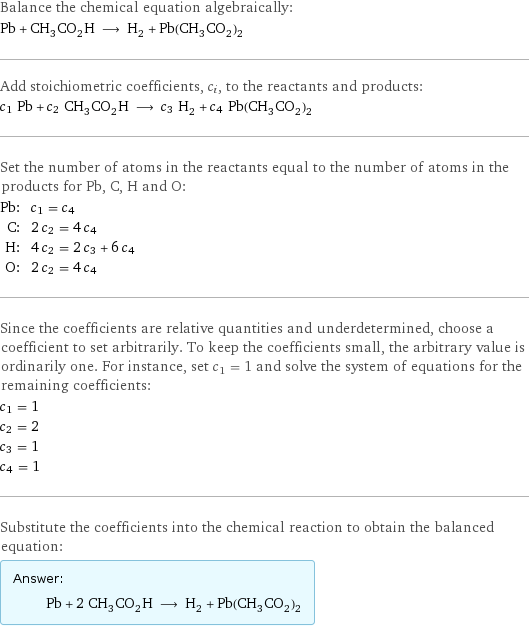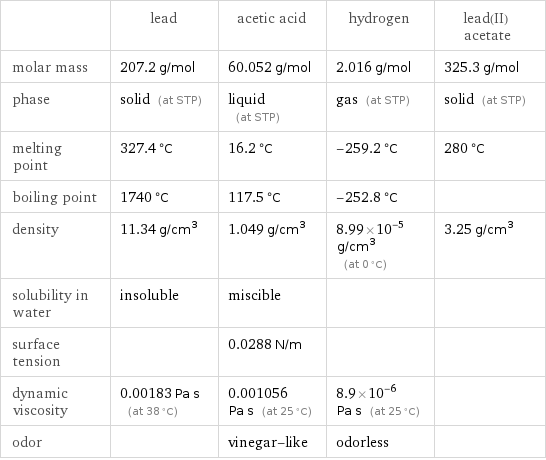Input interpretation

Pb lead + CH_3CO_2H acetic acid ⟶ H_2 hydrogen + Pb(CH_3CO_2)_2 lead(II) acetate
Balanced equation

Balance the chemical equation algebraically: Pb + CH_3CO_2H ⟶ H_2 + Pb(CH_3CO_2)_2 Add stoichiometric coefficients, c_i, to the reactants and products: c_1 Pb + c_2 CH_3CO_2H ⟶ c_3 H_2 + c_4 Pb(CH_3CO_2)_2 Set the number of atoms in the reactants equal to the number of atoms in the products for Pb, C, H and O: Pb: | c_1 = c_4 C: | 2 c_2 = 4 c_4 H: | 4 c_2 = 2 c_3 + 6 c_4 O: | 2 c_2 = 4 c_4 Since the coefficients are relative quantities and underdetermined, choose a coefficient to set arbitrarily. To keep the coefficients small, the arbitrary value is ordinarily one. For instance, set c_1 = 1 and solve the system of equations for the remaining coefficients: c_1 = 1 c_2 = 2 c_3 = 1 c_4 = 1 Substitute the coefficients into the chemical reaction to obtain the balanced equation: Answer: | | Pb + 2 CH_3CO_2H ⟶ H_2 + Pb(CH_3CO_2)_2
Structures

+ ⟶ +
Names

lead + acetic acid ⟶ hydrogen + lead(II) acetate
Equilibrium constant
![Construct the equilibrium constant, K, expression for: Pb + CH_3CO_2H ⟶ H_2 + Pb(CH_3CO_2)_2 Plan: • Balance the chemical equation. • Determine the stoichiometric numbers. • Assemble the activity expression for each chemical species. • Use the activity expressions to build the equilibrium constant expression. Write the balanced chemical equation: Pb + 2 CH_3CO_2H ⟶ H_2 + Pb(CH_3CO_2)_2 Assign stoichiometric numbers, ν_i, using the stoichiometric coefficients, c_i, from the balanced chemical equation in the following manner: ν_i = -c_i for reactants and ν_i = c_i for products: chemical species | c_i | ν_i Pb | 1 | -1 CH_3CO_2H | 2 | -2 H_2 | 1 | 1 Pb(CH_3CO_2)_2 | 1 | 1 Assemble the activity expressions accounting for the state of matter and ν_i: chemical species | c_i | ν_i | activity expression Pb | 1 | -1 | ([Pb])^(-1) CH_3CO_2H | 2 | -2 | ([CH3CO2H])^(-2) H_2 | 1 | 1 | [H2] Pb(CH_3CO_2)_2 | 1 | 1 | [Pb(CH3CO2)2] The equilibrium constant symbol in the concentration basis is: K_c Mulitply the activity expressions to arrive at the K_c expression: Answer: | | K_c = ([Pb])^(-1) ([CH3CO2H])^(-2) [H2] [Pb(CH3CO2)2] = ([H2] [Pb(CH3CO2)2])/([Pb] ([CH3CO2H])^2)](../image_source/18ea6afb47db95a2d58a5560b7dd5552.png)
Construct the equilibrium constant, K, expression for: Pb + CH_3CO_2H ⟶ H_2 + Pb(CH_3CO_2)_2 Plan: • Balance the chemical equation. • Determine the stoichiometric numbers. • Assemble the activity expression for each chemical species. • Use the activity expressions to build the equilibrium constant expression. Write the balanced chemical equation: Pb + 2 CH_3CO_2H ⟶ H_2 + Pb(CH_3CO_2)_2 Assign stoichiometric numbers, ν_i, using the stoichiometric coefficients, c_i, from the balanced chemical equation in the following manner: ν_i = -c_i for reactants and ν_i = c_i for products: chemical species | c_i | ν_i Pb | 1 | -1 CH_3CO_2H | 2 | -2 H_2 | 1 | 1 Pb(CH_3CO_2)_2 | 1 | 1 Assemble the activity expressions accounting for the state of matter and ν_i: chemical species | c_i | ν_i | activity expression Pb | 1 | -1 | ([Pb])^(-1) CH_3CO_2H | 2 | -2 | ([CH3CO2H])^(-2) H_2 | 1 | 1 | [H2] Pb(CH_3CO_2)_2 | 1 | 1 | [Pb(CH3CO2)2] The equilibrium constant symbol in the concentration basis is: K_c Mulitply the activity expressions to arrive at the K_c expression: Answer: | | K_c = ([Pb])^(-1) ([CH3CO2H])^(-2) [H2] [Pb(CH3CO2)2] = ([H2] [Pb(CH3CO2)2])/([Pb] ([CH3CO2H])^2)
Rate of reaction
![Construct the rate of reaction expression for: Pb + CH_3CO_2H ⟶ H_2 + Pb(CH_3CO_2)_2 Plan: • Balance the chemical equation. • Determine the stoichiometric numbers. • Assemble the rate term for each chemical species. • Write the rate of reaction expression. Write the balanced chemical equation: Pb + 2 CH_3CO_2H ⟶ H_2 + Pb(CH_3CO_2)_2 Assign stoichiometric numbers, ν_i, using the stoichiometric coefficients, c_i, from the balanced chemical equation in the following manner: ν_i = -c_i for reactants and ν_i = c_i for products: chemical species | c_i | ν_i Pb | 1 | -1 CH_3CO_2H | 2 | -2 H_2 | 1 | 1 Pb(CH_3CO_2)_2 | 1 | 1 The rate term for each chemical species, B_i, is 1/ν_i(Δ[B_i])/(Δt) where [B_i] is the amount concentration and t is time: chemical species | c_i | ν_i | rate term Pb | 1 | -1 | -(Δ[Pb])/(Δt) CH_3CO_2H | 2 | -2 | -1/2 (Δ[CH3CO2H])/(Δt) H_2 | 1 | 1 | (Δ[H2])/(Δt) Pb(CH_3CO_2)_2 | 1 | 1 | (Δ[Pb(CH3CO2)2])/(Δt) (for infinitesimal rate of change, replace Δ with d) Set the rate terms equal to each other to arrive at the rate expression: Answer: | | rate = -(Δ[Pb])/(Δt) = -1/2 (Δ[CH3CO2H])/(Δt) = (Δ[H2])/(Δt) = (Δ[Pb(CH3CO2)2])/(Δt) (assuming constant volume and no accumulation of intermediates or side products)](../image_source/a247d6ed39e270982a9a2e77c263fe2b.png)
Construct the rate of reaction expression for: Pb + CH_3CO_2H ⟶ H_2 + Pb(CH_3CO_2)_2 Plan: • Balance the chemical equation. • Determine the stoichiometric numbers. • Assemble the rate term for each chemical species. • Write the rate of reaction expression. Write the balanced chemical equation: Pb + 2 CH_3CO_2H ⟶ H_2 + Pb(CH_3CO_2)_2 Assign stoichiometric numbers, ν_i, using the stoichiometric coefficients, c_i, from the balanced chemical equation in the following manner: ν_i = -c_i for reactants and ν_i = c_i for products: chemical species | c_i | ν_i Pb | 1 | -1 CH_3CO_2H | 2 | -2 H_2 | 1 | 1 Pb(CH_3CO_2)_2 | 1 | 1 The rate term for each chemical species, B_i, is 1/ν_i(Δ[B_i])/(Δt) where [B_i] is the amount concentration and t is time: chemical species | c_i | ν_i | rate term Pb | 1 | -1 | -(Δ[Pb])/(Δt) CH_3CO_2H | 2 | -2 | -1/2 (Δ[CH3CO2H])/(Δt) H_2 | 1 | 1 | (Δ[H2])/(Δt) Pb(CH_3CO_2)_2 | 1 | 1 | (Δ[Pb(CH3CO2)2])/(Δt) (for infinitesimal rate of change, replace Δ with d) Set the rate terms equal to each other to arrive at the rate expression: Answer: | | rate = -(Δ[Pb])/(Δt) = -1/2 (Δ[CH3CO2H])/(Δt) = (Δ[H2])/(Δt) = (Δ[Pb(CH3CO2)2])/(Δt) (assuming constant volume and no accumulation of intermediates or side products)
Chemical names and formulas

| lead | acetic acid | hydrogen | lead(II) acetate formula | Pb | CH_3CO_2H | H_2 | Pb(CH_3CO_2)_2 Hill formula | Pb | C_2H_4O_2 | H_2 | C_4H_6O_4Pb name | lead | acetic acid | hydrogen | lead(II) acetate IUPAC name | lead | acetic acid | molecular hydrogen | lead(2+) diacetate
Substance properties

| lead | acetic acid | hydrogen | lead(II) acetate molar mass | 207.2 g/mol | 60.052 g/mol | 2.016 g/mol | 325.3 g/mol phase | solid (at STP) | liquid (at STP) | gas (at STP) | solid (at STP) melting point | 327.4 °C | 16.2 °C | -259.2 °C | 280 °C boiling point | 1740 °C | 117.5 °C | -252.8 °C | density | 11.34 g/cm^3 | 1.049 g/cm^3 | 8.99×10^-5 g/cm^3 (at 0 °C) | 3.25 g/cm^3 solubility in water | insoluble | miscible | | surface tension | | 0.0288 N/m | | dynamic viscosity | 0.00183 Pa s (at 38 °C) | 0.001056 Pa s (at 25 °C) | 8.9×10^-6 Pa s (at 25 °C) | odor | | vinegar-like | odorless |
Units
